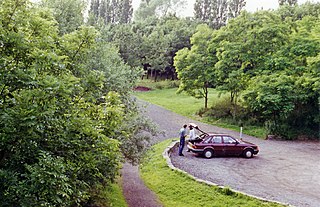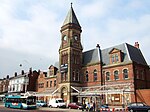The Skelmersdale branch was a standard gauge railway (SKE) which connected the Liverpool, Ormskirk and Preston Railway at Ormskirk with Rainford Junction via Skelmersdale. At Rainford it connected with the Liverpool and Bury Railway and the St. Helens Railway. It was built by the East Lancashire Railway, which was taken over by the Lancashire and Yorkshire Railway shortly afterward. The steam railmotor which served the line was sometimes known locally as the "Skem Dodger" and other times as the "Skem Jazzer".
Rainford Village railway station was on the railway line from St Helens to Rainford Junction, then Ormskirk, England.
Ann Street Halt railway station served the centre of Widnes in Cheshire, England. It was located on the southern section of the former St Helens and Runcorn Gap Railway.
Appleton railway station served a primarily industrial area of Widnes, England. It was located on the southern section of the former St Helens and Runcorn Gap Railway.

Culcheth railway station served the village of Culcheth, Warrington, then in Lancashire, later in Cheshire, England. It was situated immediately west of the bridge whereby Wigshaw Lane crossed the railway.
Union Bank Farm Halt railway station was on the southern section of the St Helens and Runcorn Gap line of the London and North Western Railway.
Clock Face railway station served the colliery village of Clock Face south of St Helens, England. The station was on the southern section of the St Helens and Runcorn Gap Railway which was later absorbed by the London and North Western Railway.

St Helens Central (GCR) railway station served the town of St Helens, England with passenger traffic between 1900 and 1952 and goods traffic until 1965. It was the terminus of a branch line from Lowton St Mary's.
Tanhouse Lane railway station is a closed station on the former Sheffield and Midland Railway Companies' Committee line, which formed a loop off the Cheshire Lines Committee (CLC) line in the Widnes area between Liverpool Central and Manchester Central. It was opened on 1 September 1890 as "Tanhouse", being changed later to "Tanhouse Lane". It closed on 5 October 1964.
Gerards Bridge railway station was on the St Helens to Rainford Junction then Ormskirk line immediately north of Haresfinch Road in St Helens, England. It opened on 3 February 1858 and closed on 1 August 1905. Remnants of the line through the station survive, leading to Pilkington's Cowley Hill site, though in September 2015 the tracks were out of use.
Moss Bank railway station was on the St Helens to Rainford Junction then Ormskirk line on the northern edge of St Helens, England. It opened on 3 February 1858 and closed to passengers on 18 June 1951. The line through the station closed in 1964 and has since been lifted.
Old Mill Lane railway station was on the St Helens to Rainford Junction then Ormskirk line south of Rainford, England. It opened on 1 August 1906 and closed on 18 June 1951. The line through the station closed in 1964 and has since been lifted. The station has been demolished.
Rookery railway station was on the St Helens to Rainford Junction then Ormskirk line southeast of Rainford, England.
Hey's Crossing Halt railway station was on the Skelmersdale branch, which ran from Ormskirk to Rainford Junction via Skelmersdale. Most trains ran beyond Rainford Junction through to St Helens. It opened in 1911 and closed on 18 June 1951. The line through the station was closed in 1964 and subsequently lifted. Hey's Crossing Halt has been demolished.
White Moss Level Crossing Halt railway station was on the Skelmersdale branch, which ran from Ormskirk to Rainford Junction via Skelmersdale. Most trains ran beyond Rainford Junction through to St Helens. The halt opened on 7 January 1907 and closed on 18 June 1951. The line through the station closed in 1964 and was subsequently lifted. The station was demolished and its site is now buried under the M58 motorway.

Westhead Halt railway station was on the Skelmersdale branch, which ran from Ormskirk to Rainford Junction via Skelmersdale. Most trains ran beyond Rainford Junction through to St Helens.
Farnworth & Bold railway station served the Farnworth area of Widnes, England. The station was on the southern section of the St Helens and Runcorn Gap Railway which was later absorbed by the London and North Western Railway.
Sutton Oak railway station served the southern area of St Helens, England. The station was on the central section of the St Helens and Runcorn Gap Railway which was later absorbed by the London and North Western Railway.
Peasley Cross railway station served the central southern area of St Helens, England. It was situated on the central section of the St Helens and Runcorn Gap Railway which was later absorbed by the London and North Western Railway.
Haydock railway station served the village of Haydock, formerly in Lancashire, now in Merseyside, England.








